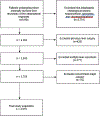Impact of liver cirrhosis, severity of cirrhosis and portal hypertension on the difficulty of laparoscopic and robotic minor liver resections for primary liver malignancies in the anterolateral segments
- PMID: 37984243
- PMCID: PMC11293421
- DOI: 10.1016/j.ejso.2023.107252
Impact of liver cirrhosis, severity of cirrhosis and portal hypertension on the difficulty of laparoscopic and robotic minor liver resections for primary liver malignancies in the anterolateral segments
Abstract
Introduction: We performed this study in order to investigate the impact of liver cirrhosis (LC) on the difficulty of minimally invasive liver resection (MILR), focusing on minor resections in anterolateral (AL) segments for primary liver malignancies.
Methods: This was an international multicenter retrospective study of 3675 patients who underwent MILR across 60 centers from 2004 to 2021.
Results: 1312 (35.7%) patients had no cirrhosis, 2118 (57.9%) had Child A cirrhosis and 245 (6.7%) had Child B cirrhosis. After propensity score matching (PSM), patients in Child A cirrhosis group had higher rates of open conversion (p = 0.024), blood loss >500 mls (p = 0.001), blood transfusion (p < 0.001), postoperative morbidity (p = 0.004), and in-hospital mortality (p = 0.041). After coarsened exact matching (CEM), Child A cirrhotic patients had higher open conversion rate (p = 0.05), greater median blood loss (p = 0.014) and increased postoperative morbidity (p = 0.001). Compared to Child A cirrhosis, Child B cirrhosis group had longer postoperative stay (p = 0.001) and greater major morbidity (p = 0.012) after PSM, and higher blood transfusion rates (p = 0.002), longer postoperative stay (p < 0.001), and greater major morbidity (p = 0.006) after CEM. After PSM, patients with portal hypertension experienced higher rates of blood loss >500 mls (p = 0.003) and intraoperative blood transfusion (p = 0.025).
Conclusion: The presence and severity of LC affect and compound the difficulty of MILR for minor resections in the AL segments. These factors should be considered for inclusion into future difficulty scoring systems for MILR.
Keywords: Cirrhosis; Difficulty score; Laparoscopic hepatectomy; Laparoscopic liver; Minimally-invasive hepatectomy; Minimally-invasive liver.
©2023 Published by Elsevier Ltd.
Conflict of interest statement
Declaration of competing interest
Figures
References
-
- Ciria R, Cherqui D, Geller DA, Briceno J, Wakabayashi G. Comparative Short-term Benefits of Laparoscopic Liver Resection: 9000 Cases and Climbing. Ann Surg [Internet]. 2016. [cited 2022 Jul 15];263(4):761–77. Available from: https://pubmed.ncbi.nlm.nih.gov/26700223/ - PubMed
-
- Goh BKP, Lee SY, Teo JY, Kam JH, Jeyaraj PR, Cheow PC, et al. Changing trends and outcomes associated with the adoption of minimally invasive hepatectomy: a contemporary single-institution experience with 400 consecutive resections. Surg Endosc. 2018. Nov 1;32(11):4658–65. - PubMed
-
- Wakabayashi G, Cherqui D, Geller DA, Buell JF, Kaneko H, Han HS, et al. Recommendations for laparoscopic liver resection: a report from the second international consensus conference held in Morioka. Ann Surg [Internet]. 2015. Apr 1 [cited 2022 Jul 23];261(4):619–29. Available from: https://pubmed.ncbi.nlm.nih.gov/25742461/ - PubMed
-
- Hilal MA, Aldrighetti L, Dagher I, Edwin B, Troisi RI, Alikhanov R, et al. The Southampton Consensus Guidelines for Laparoscopic Liver Surgery: From Indication to Implementation. Ann Surg. 2018. Jul 1;268(1):11–8. - PubMed
-
- Linn YL, Wu AG, Han HS, et al. Systematic review and meta-analysis of difficulty scoring systems for laparoscopic and robotic liver resections. J Hepatobiliary Pancreat Sci 2022. - PubMed
Publication types
MeSH terms
Grants and funding
LinkOut - more resources
Full Text Sources
Medical
Miscellaneous


